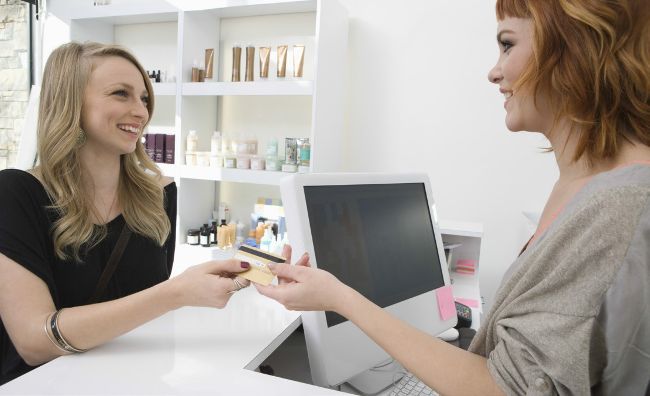THE THORNY ISSUE OF PRICE INCREASES
With the cost of living escalating, how often should you be increasing your treatment and retail prices? And, how will your clients react? Salon owner Hellen Ward shares some tried-and-test advice

IMAGE: SHUTTERSTOCK
Whenever I am out and about at industry events, the topic I get quizzed about the most is the issue of price increases, especially since the pandemic. It’s a problem we all face in the sector and opinions on how to handle it vary. How often price increases should happen (if at all?) and by how much? More importantly – just how should you go about it?
1. Little and often or go big?
I find it works much better to be able to explain a price rise if a decent amount of time has elapsed since the last one. Having carried out research on our client base, we were told in no uncertain terms that they preferred a bigger increase less often, instead of constant little regular price hikes that they would notice at each visit (it’s futile to think they won’t – they do). So, we adopted a policy of doing a more substantial rise every 18 months.
“It’s never going to be easy to judge client behaviour and how they might react to an increase, especially if they are loyal and regular spenders, so being flexible is key.”
In general terms, the price increase is around 5-10% on our services (but see point 4!). Being able to say that your business has swallowed rising costs but you haven’t put your prices up for a year and a half certainly makes customers more sympathetic.
2. Should you treat retail and services differently?
Retail tends to be a bit different, as supplier costs are rising constantly – our main supplier used to do one annual price rise, but in 2022 did a mid-year hike, too. Customer psychology-wise, adapting and amending the price of retail products is more accepted because we are all buying goods all the time and seeing the prices rise constantly, so there is a greater consensus of understanding that product prices will change.
If a product is costing you more to buy in, it’s unlikely you’ll make enough margin if you don’t adapt your retail price, whereas even productheavy services are more personal and involve the operator’s time, so are viewed by clients as more flexible.
3. Shout it out or hide it?
We place a discreet sign at reception informing clients just before we instigate a rise – the date of the rise clearly displayed – and leave it in place for a good three months so people who don’t come as regularly can see that we did notify people beforehand.
We also post on social media explaining why we are raising some prices, and letting people know how long it’s been since the last rise. It’s worth mentioning it at the point of booking – but only if handled correctly and subtly – as in: “Just so you’re aware, and you might have seen from our social media and on our website, please note that we’ve had a slight price increase on some of our services.”
Finish by reminding the client how long it was since the last one, too.
4. Be prepared to go down as well as up
Okay, it may not happen often, but sometimes we adjust prices and decrease them because the general market value of the service has declined not risen (think microwaves or digital fitness trackers).
For us, manicures have become normalised and more widely available, so the price point of nail services is a real case in point; we charge less now than we did 10 years ago.
It’s always worth pointing out when this happens as it makes clients understand you are being fair and taking the time to research the market and your competition – and that can mean price adjustments either way.
5. Be flexible and adaptable
Tell your staff that they can negotiate. Empower them to understand that retaining the client has to be the priority, so if they feel they might lose someone, keep them at the old rate for an agreed period of time. To do this, however, make sure you make full use of your computer software and write detailed notes so nobody is shouting out, “But I don’t pay that” in front of people who do. Also, this should be treated as an exception, not a rule, so encourage your team to treat it as such. What you don’t want is everybody paying different prices.

IMAGE: SHUTTERSTOCK
“Customer psychology-wise, adapting and amending the price of retail products is more accepted because we are all buying goods all the time and seeing the prices rise constantly.”
6. Protect your ‘rack rate’ at all costs
Perhaps the most important tip is to remember that your online price point should be your highest. Think hotels that have deals with corporate companies – they might discount their room rate for valued customers privately by separate arrangement but the price as advertised digitally is the acknowledged rate. The price you market publicly can just be used as the price point for new clients, and you can deal with existing clients specifically by offering them time-limited price fixes if you feel the need. Remember, you can always go down, but it’s far harder to go up, so make sure your digital presence gives you the leeway to do just that.
Your website price is also a good indicator for those clients who are paying old prices – they can see just how much discount they are getting.
7. Try adding value
Try a different approach and make the service more valuable. For instance, for your senior team members (who should be charging more for their expertise) add in a freebie. We use conditioning treatments, goody bags, and other tools to do this. In our Metrospa, we’ve just started burning a branded candle during face or body treatments and then giving it to the client at the end as a gift. Adding value is always better than damaging the price point.
It’s never going to be easy to judge client behaviour and how they might react to an increase, especially if they are loyal and regular spenders, so being flexible is key. We are all facing inflation at a rate we haven’t seen for decades, and the resulting cost-of-living crisis means we are all feeling the pinch.
For those reluctant to risk losing business by increasing their prices, it’s a call you have to make, having studied the numbers and your history of price rises. You may have no option, but using my guide and being flexible should help retain business.
One thing is certain – failing to do your market analysis and study the competition’s pricing is a mistake we cannot afford to make, especially in the current climate.

Hellen Ward is managing director of Richard Ward Hair & Metrospa in London and a beauty ambassador for the National Hair & Beauty Federation (NHBF).